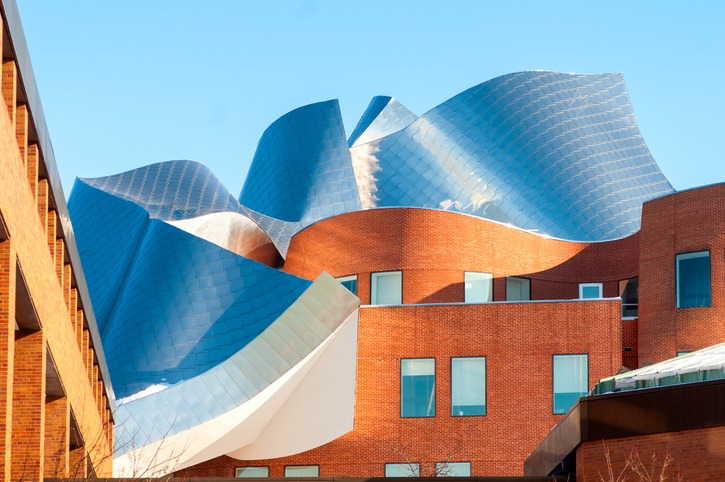Some believe that we live in the modern era, but others think we are not. Some people prefer to refer to our time as the postmodern era. For academics and artists, postmodernism is a way to describe the second half of the twentieth century and its reactions to the early twentieth century’s ideals. It’s a broad category that resists categorization yet has impacted numerous art forms, including architecture.
Understanding Postmodern Architecture
In the late 1970s, an architectural and ornamental art trend known as “postmodernism” arose and has since taken on many other forms. The rise of art movements like Modernism, which prohibited the use of historical references in architecture, sparked the rise of postmodernism. During the peak of Modernism, a few well-known landmarks in significant cities underwent considerable remodeling. Many historic structures were dismantled and replaced with stifled replicas that had little consideration for their surroundings’ artistic characterizations.
Postmodern architecture is a 20th-century trend characterized by an irreverent and eclectic jumble of classic and modern components to make unique works of architecture that seek to appear as nothing else has come before. Postmodern architecture has produced some of the world’s most contentious, eccentric, and memorable buildings. Postmodern architecture emphasized free-thinking design and environmental sensitivity. These concerns included incorporating the design of surrounding buildings into new, contemporary structures. An excellent example of this thorough study is James Stirling and Michael Wilford’s The Neue Staatsgalerie, which incorporates neoclassical characteristics with a dash of postmodern flair.
While the postmodern architecture was designed to serve a purpose, postmodernism promoted innovation. It deviated from modern ideals of simplicity, abstraction, and basic shapes, by blending architectural themes and features from the Arts and Crafts movement, classicism, neoclassicism, and other forms. Postmodern architecture aimed to create buildings that honored their local heritage and had a unique visual appeal.
However, postmodern architecture is criticized for not blending well with its environment, as architects rarely constructed buildings to complement existing structures. This kept many from appreciating postmodern work, although the idea of good design began to change over time. Eventually, postmodernism took root, and its global principles glorified the future rather than the past. Because of this shift in public opinion, postmodernism has grown into a widely accepted term of art.
History of Postmodern Architecture
Postmodernism emerged in the 1960s and ’70s as an architect-driven reaction against Modern architecture of the mid-20th century, which postmodern architects saw as placeless and rigid, created from sleek modern materials like steel and glass and lacking in beauty and emotion. Postmodern architects believed Modernism’s utopian aspirations of accessible architecture for the public had failed, and its cultural moment had passed an assertion which, judging by the enduring 21st-century popularity of modernist aesthetics, has not weathered the test of time. Postmodernism welcomed complexity and contradiction, as argued in Robert Venturi’s 1966 book Complexity and Contradiction in Architecture.
Postmodern buildings with personality, wit and a satirical take on historical architectural components and movements forsake traditional beauty and good taste. Postmodern architecture can seem tasteless and camp to the untrained because they mix styles. Postmodernism blossomed during the 1980s economic boom and persisted into the 1990s, leaving behind loud, proud, genre-defying architectural monuments throughout the U.S., Europe, Japan, and Australia. Postmodernism affects modern architecture.
Distinguishing Features of Postmodern Architecture
With such a wide variety of postmodern buildings, the standards for what characterizes postmodern art is unclear. Mary McLeod described the trend as a desire to represent culture through the building. Postmodernism rejected rules and encouraged artists to be imaginative and extravagant.
- Contradiction. Postmodernism was an antithesis of all the movements that came before it, gathering influence from various cultures and design components to create art that had never been seen before. In the Humana Building in Louisville, Kentucky, designer Michael Graves combined approaches from several movements to preserve history and promote progressive design.
- Asymmetry. Asymmetry was a postmodern pillar because it created unusual, eye-catching architecture. Slanting pillars, walls, and opposing structures were common in postmodern works and redefined functional architecture. Angles and lines worked to create postmodernism as a movement to watch. The Groninger Museum’s three significant pavilions feature asymmetrical designs, colors, and mediums.
- Humor. Both comedy and camp, an ironic movement of flamboyant art considered beautiful, were employed simultaneously throughout the postmodern period, especially in the United States. Camp’s postmodern work elevated the postmodern movement’s protest against Modernism to new heights. Theatrical buildings like Hotel Dolphin (1987) at Walt Disney World in Orlando, Florida, used humor and overindulgence. By challenging formality, camp architects fostered inventiveness in new design and construction.
- Fragmentation. Postmodern architects created fragmented buildings that appeared to be numerous different buildings with varied functions. Titanium, the substance used to make the Guggenheim Museum Bilbao, changes color in the light. This gave the building a different look in the daytime and evening.
- Complexity. All postmodern works are complex because they combine color schemes, textures, shapes, and themes. Complexity was employed to break from Modernism’s uniformity and create a new design style. Frank Gehry’s Dancing House uses diverse materials and lines to create an ethereal edifice.
Most Iconic Postmodern Architecture
1. Piazza D’Italia (1978)
Charles Moore built Piazza D’Italia in New Orleans in 1978. This public square has a range of outrageous Italian architectural icons, including fountains, canopies, and columns. The architectural marvel was restored in 2004 to repair deterioration caused by a lack of development.
2. The Portland Building (1982)
The Portland Building, designed by Michael Graves, was one of the earliest postmodern buildings to use reinforced concrete and fiberglass. Graves’ work used unique design principles on each side of the building, while many modernist buildings used glass to induce mysticism. By presenting a fresh approach to display the same traits, Graves helped postmodern cement design as a long-term movement.
3. Bank of America Center (1984)
The Bank of America Center (previously NationsBank Center) was erected in Houston in 1983 by Johnson-Burgee Architects. The building is split into three towers with gable roofing and spires to create a medieval-inspired appearance and keep birds off its various ledges. This building blends utility with exuberant design to illustrate postmodern design’s inspirations.
4. The Neue Staatsgalerie (1984)
This structure by James Stirling and Michael Wilford has neoclassical and industrial elements. Warm hues and natural textures were employed to keep the design in sync with its surroundings. Postmodern features include industrial and neon. This combination created a revolutionary tower that could stand among historic structures.
5. Thompson Center (1985)
The Thompson Center, built in the 1980s in Chicago, Illinois, stands out in size and shape. The circular glass skyscraper designed by Helmut Jahn represents the government’s commitment to continuous improvement and openness.
6. Wexner Center for the Arts (1989)
A perfect example of postmodernism fragmentation and contradiction can be seen in the Wexner Center for the Arts. The facility provides visual and performing arts at Ohio State University. By combining various materials and styles, the structure helped define American architecture at the time.
7. BSIS (1994)
The Secret Intelligence Service’s (SIS) Vauxhall Pleasure Gardens headquarters was erected in 1994 by Terry Farrel. As the U.S. was the birthplace of postmodernism, the SIS building is one of Europe’s most noteworthy examples. The SIS combines shapes, mediums, and themes to create a unique structure in the U.K.
8. Building Binoculars (2001)
Binoculars Building, also called the Chiat/Day Building, was constructed in 2001 and included significantly bigger artwork by Claes Oldenburg and Coosje van Bruggen. This postmodern construction balances camp and utility by employing the binoculars’ arch as an entrance.
The postmodern style allowed designers to find inspiration from several disciplines and eras, shaping modern skylines. Postmodern leaders encouraged architects to experiment with how a structure could look, which is the basis for many aesthetic expressions today.



